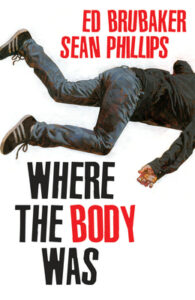Gosh, I wish every aspiring literary thriller author who’s planning on writing some heartfelt, wordy, incredibly dreary and often borderline racist tale of suburban scandals would just read this graphic novel and go ahead and reevaluate whether this manuscript they’re working on actually says anything that the Brubaker/Phillips crew hasn’t covered perfectly already.
 My day job is the crime beat, and let me tell you, I have read so much junk masquerading as elevated prose applied to the suburban whodunnit that it makes me want to tear my hair out. Grace Metalious’ Peyton Place was the scandalous, trailblazing ur-text of this subgenre, but she definitely did not take it as seriously as some of the authors operating in the field today. Dear modern authors: it’s okay to write entertaining prose that doesn’t aspire to literary greatness via tortured text renderings of a person’s incredibly banal interior life. People grieve, we get it, but y’all writers need to give readers a reason to care about that person before we can care about their sadness. Because sadness? It isn’t unique. Last year was the shittiest year of my life and my grief bored even me, and I say that as someone who actually cares deeply about myself.
My day job is the crime beat, and let me tell you, I have read so much junk masquerading as elevated prose applied to the suburban whodunnit that it makes me want to tear my hair out. Grace Metalious’ Peyton Place was the scandalous, trailblazing ur-text of this subgenre, but she definitely did not take it as seriously as some of the authors operating in the field today. Dear modern authors: it’s okay to write entertaining prose that doesn’t aspire to literary greatness via tortured text renderings of a person’s incredibly banal interior life. People grieve, we get it, but y’all writers need to give readers a reason to care about that person before we can care about their sadness. Because sadness? It isn’t unique. Last year was the shittiest year of my life and my grief bored even me, and I say that as someone who actually cares deeply about myself.
In all honesty, if I’d realized that this book was meant to be a suburban thriller, I’d have probably passed on it. I know Ed Brubaker as more of a heist/noir writer, so I was expecting more of that. The 80s setting, crosscut with modern day panels, fit the quasi-historical lens of his that I’m used to, so by the time I realized this was basically suburban shenanigans, I was already too hooked to try to flail away.
But here’s the thing. For cishet white guys working in my least favorite crime subgenre, this was a surprisingly inoffensive take on it. Sean Phillips’ art, ofc, cuts out the necessity of using a bajillion extraneous words, but I also really appreciated the depictions of the Black and Asian characters here. Lila Nguyen, especially, is a plucky superheroine-wannabe who navigates prejudice with the kind of aplomb I’m all too familiar with from growing up in a similar situation.
Anyway, Lila is skating down her street one summer when she comes across a body. But she’s also been secretly recording what’s been going on in her neighborhood, and soon finds herself embroiled in way more adult goings-on than she’d ever expected. Saying more would be spoiling it, but let’s just say that there’s plenty of intrigue — as well as a surprising amount of pathos — in this neighborhood that includes a boardinghouse of junkies, duplicitous spouses and people living double lives.
One of the best tools used here is the framing technique where we also see what happens to the inhabitants of Pelican Road some thirty plus years after the incident with the body. The closure, after a fashion, is bittersweet (tho I still think Toni gets robbed.) Another excellent tool is Jacob Phillips’ use of color, especially on faces. His highlights and shadows work perfectly with Sean Phillips’ lines to evoke mood and infuse realism to an already profoundly believable tale.
And I don’t want to stop authors, especially from underrepresented backgrounds, from telling their own tales of suburban woe. But make it smart, like this team here does, make it fresh. Make it interesting. I guess my real advice is to encourage writers to read more and widely, because Where The Body Was is the best suburban thriller I’ve enjoyed since Liane Moriarty’s Big Little Lies (which, as we all know, is a commercial thriller, not literary) and deserves way more praise than some of the absolutely shit books that have inexplicably landed on critics’ choice lists in recent years. Please, “literary” authors, please read this concise, terrific book so I don’t have to suffer through any more pretentious nonsense from you and your ilk.
Where The Body Was by Ed Brubaker, Sean Phillips & Jacob Phillips was published January 16 2024 by Image Comics and is available from all good booksellers, including
